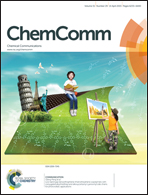H+-Assisted fluorescent differentiation of Cu+ and Cu2+: effect of Al3+-induced acidity on chemical sensing and generation of two novel and independent logic gating pathways†
Abstract
A novel Schiff base probe exhibited strong ‘turn-ON’ fluorescence for Cu2+ at 345 nm, Al3+ at 445 nm, and Cu+ at 360 nm in the presence of Al3+ in organic solvent (acetonitrile), which allowed for construction of molecular logic gates ‘INH’ and ‘1:2 DEMULTIPLEXING.’ H+ generated from Al3+ contributed greatly to Cu+ chemosensing based on a redox non-innocence mechanism.

- This article is part of the themed collection: Molecular Logic Gates and Information Processing

 Please wait while we load your content...
Please wait while we load your content...